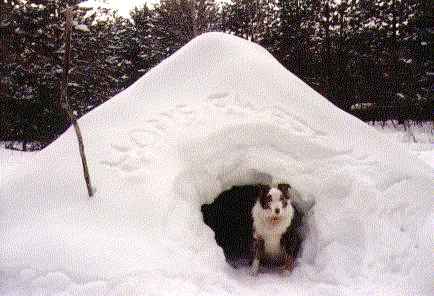 | |
|
| |
Snow Quinzee Hut | |
| Here
is a description of how to build a snow quinzee or snow mound hut. These, like
most other snow shelters, require a fair bit of work to complete, therefore
start well before dark. These are usually used when you plan on spending more
than one night in the same spot due to the effort involved in making this.
If built properly a quinzee hut will be much warmer to sleep in than any tent.
Basically, this is a combination of an igloo and a snow cave. You are going to shovel a pile of snow into the shape and size of an igloo. Let it harden and then hollow it out. This is especially useful in marginal snow conditions, or when a crust is not available for igloos and also when there is not enough (5-10 feet) deep packed snow for a snow cave. The quinzee hut is possible because temperature differences exist within the layers of snow. By mixing snow of different temperatures you create a sintering process that causes even powdered snow to harden. For a quinzee with an inside diameter of 6 ft., mark off a circular area that is at least 8-10 ft. in diameter (allowing for the walls). Now mix up the snow within your circle to get it sintering. Start piling snow on top of this area by using snow that is from outside of the circle. As you shovel, alternate flipping the snow over so that it gets well mixed (one shovel full right side up, the next gets thrown on upside down...). Your pile should get to about 6 ft. high. Flatten off the top to give it a dome shape, but don't pack down the snow. Poke a couple dozen 1-2 ft. long sticks through the top and sides of your snow pile and leave them in the snow. These will be your guides to the wall thickness when you start digging it out. Now you sit and wait to let the sintering process do its thing. Depending on the outside temperature it could take between one and three hours. The colder it is the faster it will harden. Make yourself something hot to drink, cook dinner or go on a short hike to pass the time and keep warm. Now it's time to dig. You should be in waterproof clothes and someone else should help to move away the debris you shovel out. Trade off regularly, the person inside doing the digging has the toughest job. Use the excavated snow to make a sitting and cooking area just outside your shelter along with a wind break. Start off by making a small opening at ground level. As you progress inwards, start slanting upwards so that the sleeping platform is slightly raised. This will allow the coldest air to flow down and out while you are sleeping. Keep hollowing out until you reach the ends of the sticks you poked through earlier. When finished the walls should be at least 1-2 ft. thick and you should have a dome shaped ceiling. Smooth the ceiling as much as possible to prevent dripping. Ventilation: You will get a thin crust of ice build up on the inside, due to condensation, making the snow airtight. You will need to make, and keep clear, a ventilation hole in the ceiling. Also, don't shut the door up too snugly, allow some air to circulate through it. You can use your pack as the door. Mark your entrance by standing you ski poles or snowshoes on either side of it. Scoop out a shelf or two on the inside wall for candles. Poke a stick part way through to suspend your candle lantern. You may also want to make a windbreak out of snow around the entrance. This will keep brisk winds out as well as to help prevent drifting snow from burying your doorway. Just as a precaution you should keep your shovel or other digging utensil inside with you at night in case you have to excavate your way out in the morning. Cooking inside is not recommended (due to CO build up), but if you must make sure you have an extra ventilation hole directly above your stove. Always leave the doorway partially opened while the stove is on. Set the stove outside when you first turn it off; this is when it gives off the most fumes. It is also a good idea to bring along a small tarp or tent fly. In the dead of winter it can still rain. Some unfortunate campers have found this out the hard way. During the night it warmed up and rained hard. They woke up at 5:00 a.m. with their quinzee caving in on them followed by pouring rain. Everything got soaked. Later that morning the temperature dropped back down and all of their gear and clothing was frozen solid. Throwing tarps over the roof of your quinzee during a rain storm will greatly increase it's chances of making it through the night. Just make sure your ventilation hole is not obstructed. If so you'll have to poke another one off to the side. A tarp or ground sheet is also required for the floor. Set this down and put your sleeping bags on top. You might also want to consider a bivouac cover for your sleeping bag to prevent your bag from getting wet from falling snow when you accidentally brush your head against the roof of the quinzee. These shelters are perfect for 2 or 3 people. If you have more in your group then you can build two adjoining quinzees with a small opening connecting them. | |
| Written
By: Mike Nowacki | |
